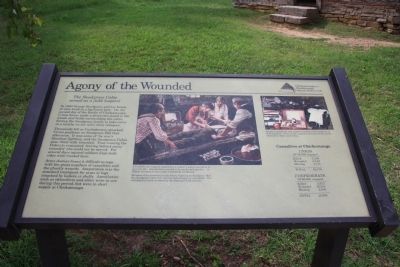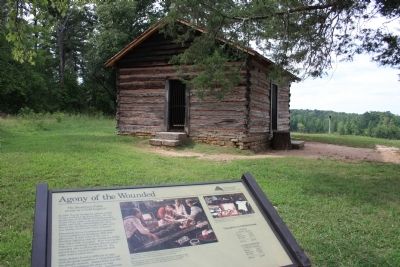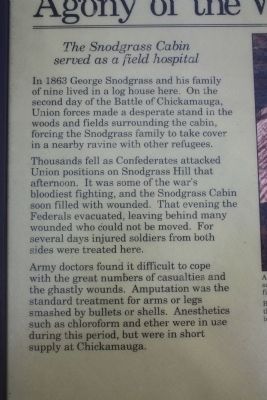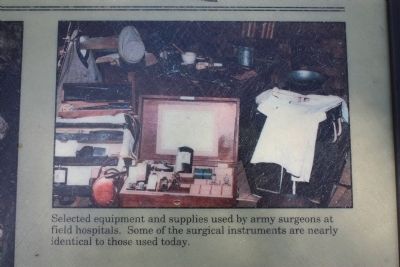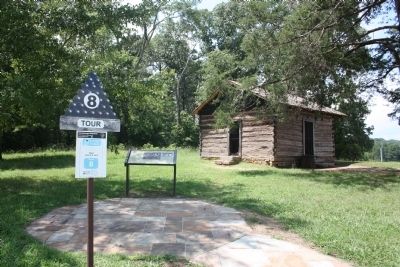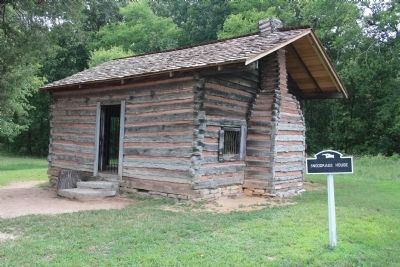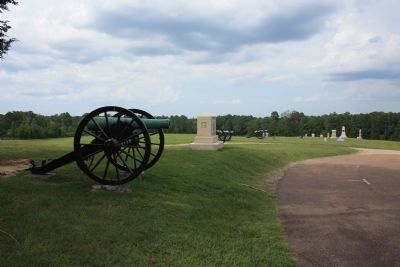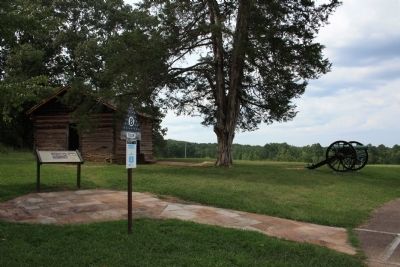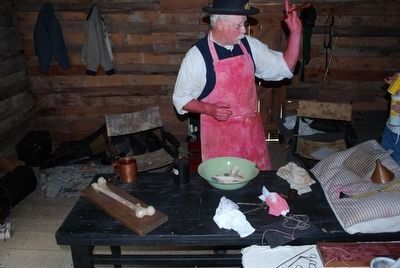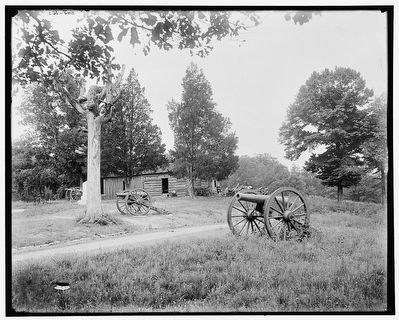Near Fort Oglethorpe in Walker County, Georgia — The American South (South Atlantic)
Agony of the Wounded
served as a field hospital.
In 1863 George Snodgrass and his family of nine lived in a log house here. On the second day of the Battle of Chickamauga, Union forces made a desperate stand in the woods and fields surrounding the cabin, forcing the Snodgrass family to take cover in a nearby ravine with other refugees.
Thousands fell as Confederates attacked Union positions on Snodgrass Hill that afternoon. It was some of the war's bloodiest fighting, and the Snodgrass Cabin soon filled with wounded. That evening the Federals evacuated, leaving behind many wounded who could not be moved. For several days injured soldiers from both sides were treated here.
Army doctors found it difficult to cope with the great numbers of casualties and the ghastly wounds. Amputation was the standard treatment for the arms or legs smashed by bullets or shells. Anesthetics such as chloroform and ether were in use during this period, but were in short supply at Chickamauga.
Union
Of 58,000 engaged
————————
Killed .... 1,656
Wounded ... 9,749
Missing ... 4,774
————————
Total .... 16,179
Confederate
Of 66,000 engaged
————————
Killed .... 2,673
Wounded .. 16,274
Missing ... 2,003
————————
Total .... 20,950
A Confederate surgeon amputates a soldier's arm in an effort to save his life. Amputations needed to be performed quickly - in fifteen minutes or less under battlefield conditions.
Because of its proximity to the heavy fighting on Snodgrass Hill, the Snodgrass cabin was used by both armies as a hospital. The building has been restored by the National Park Service.
[Caption under small picture]:
Selected equipment and supplies used by army surgeons at field hospitals. Some of the surgical instruments are nearly identical to those used today.
Erected by Chickamauga-Chattanooga National Military Park.
Topics. This historical marker is listed in this topic list: War, US Civil. A significant historical year for this entry is 1863.
Location. 34° 55.746′ N, 85° 16.099′ W. Marker is near Fort Oglethorpe, Georgia, in Walker County. Marker is on Vittetoe Road west of Vittetoe-Chickamauga Road, on the right when traveling west. This historical
marker is located in the northwest section of the Chickamauga National Military Park, along a ridge called Snodgrass Hill. To view this historical marker drive to the parking area in front of the Snodgrass House and the marker can be seen situated just to the south of the Snodgrass House. Touch for map. Marker is in this post office area: Fort Oglethorpe GA 30742, United States of America. Touch for directions.
Other nearby markers. At least 8 other markers are within walking distance of this marker. Battery I, 4th U.S. Artillery. (a few steps from this marker); a different marker also named Battery I, 4th U.S. Artillery. (a few steps from this marker); Wood's Division (within shouting distance of this marker); Sirwell's Brigade (within shouting distance of this marker); 3rd Kentucky Infantry Regiment (US Volunteers) (about 300 feet away, measured in a direct line); 37th Indiana Infantry (about 300 feet away); Harker's Brigade (about 300 feet away); 64th Ohio Infantry (about 300 feet away). Touch for a list and map of all markers in Fort Oglethorpe.
More about this marker. This historical marker is located at stop 8 on the Chickamauga Battlefield Tour Route, that was created for this National Military Park.
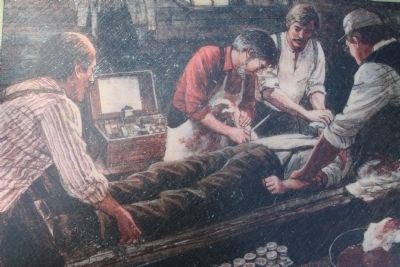
Photographed By Dale K. Benington, July 18, 2012
4. Agony of the Wounded Marker
A Confederate surgeon amputates a soldier's arm in an effort to save his life. Amputations needed to be performed quickly - in fifteen minutes or less under battlefield conditions.
Because of its proximity to the heavy fighting on Snodgrass Hill, the Snodgrass cabin was used by both armies as a hospital. The building has been restored by the National Park Service.
Credits. This page was last revised on June 16, 2016. It was originally submitted on December 15, 2012, by Dale K. Benington of Toledo, Ohio. This page has been viewed 642 times since then and 40 times this year. Photos: 1, 2, 3, 4, 5, 6, 7, 8, 9. submitted on December 15, 2012, by Dale K. Benington of Toledo, Ohio. 10, 11. submitted on August 19, 2015, by Brandon Fletcher of Chattanooga, Tennessee.
